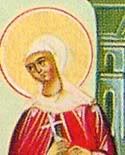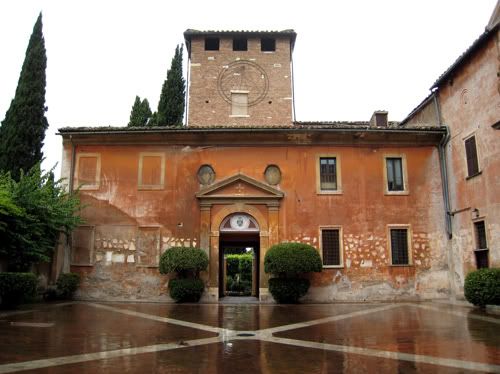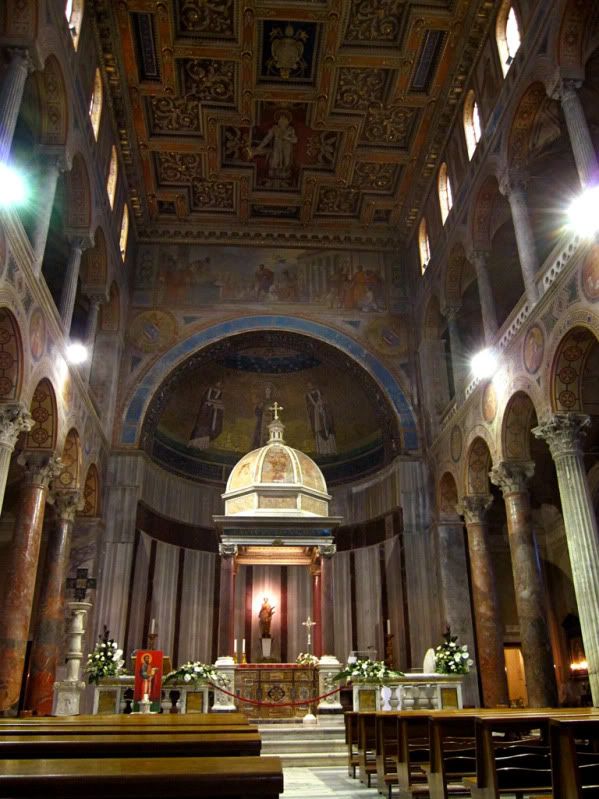Born into a wealthy Roman family during the reign of Emperor Diocletian, Agnes dedicated her young life to Christ, refusing suitors, and spurning worldly marriage. Given her grace and beauty, many wealthy and powerful families were interested in betrothing their sons to Agnes, but she remained chaste and focused only on her relationship with Christ, her “husband,” and the husband of the Church.
White some details are unclear regarding Agnes’ short life, tradition holds that a young Roman, likely the son of high-ranking prefect of Rom (either Maximum Herculeus or Sempronius), wanted to marry Agnes. Upon this request being made, Agnes is reported to have replied, ”The one to whom I am betrothed is Christ, whom the angels serve." With that, as Christians were forbidden to practice the faith at that time, under order of Emperor Diocletian, Agnes was forcibly removed from her home and brought before a judge to stand trial.
Saint Agnes was then subjected to various tortures and threats of torture, during which she never renounced her faith. The judges, losing patience, asked her to offer incense to the pagan god Minerva, which she refused. During the trial, a large crowd gathered, and one judge, taking pity on her and attempting to prevent her execution, offered her hand in marriage to the men in the crowd. Agnes adamantly refused, stating, "It is wrong for the bride to keep the bridegroom waiting. He who chose me first shall be the only one to have me. What are you waiting for, executioner? Destroy this body, for unwanted eyes may desire it." As such, a young man in the crowd who looked at Agnes lustfully was struck blind.
The judges ordered Agnes stripped naked and dragged through the streets of Rome to a brother, where she would be forced to lose her virginity. During the trip, Agnes’ hair miraculously grew, covering her body, and maintaining her chastity and purity. Pleading to Christ for aid, Agnes was left miraculously unharmed during this torment.
Having failed to convince Agnes to renounce Christ, she was sentenced to death. Agnes went to her death cheerfully, at peace, ready to be reunited with Christ. As her wrists were too small for shackles, she willingly accompanied her persecutors without restraints. At first, Agnes was tied to a pyre to be burnt alive, but the wood reportedly would not catch fire. She was then stabbed in the throat, a death considered “gentle,” and reserved for women at that time. Tradition suggests that her blood did not soak into the ground, but remained, and was later removed by Christians using clean white woolen cloths.
Two days later, Agnes’ foster sister (the daughter of her wet nurse), Emerentiana, visited Agnes’ grave to pray for her soul. Discovered by a group of Roman citizens, Emerentiana was stoned to death, a martyr for her faith, and later canonized by the Church. Her feast day is January 23.
Agnes body was buried outside the city of Rome, rather than being thrown into the River Tiber as was common at the time. Her parents, who visited the grave via an underground tunnel, reported seeing a vision of Agnes, surrounded by other virgins, with a lamb at her side. Years later, during the reign of Constantine (when Christianity was again acceptable), his daughter Constantina was miraculously cured of leprosy after visiting the grave of Saint Agnes. Following that miracle, a great basilica was built in her honor, known as Sant'Agnese Fuori la Mura (The Basilica of St. Agnes Outside the Wall).
Each year, in honor of Agnes’ purity, a solemn feast day Mass is held. During that Mass, two young lambs from the fold raised by Trappist monks of the Tre Fontane Monastery are crowned and placed in straw baskets, decorated with red and white flowers and streamers. The red represents the martyrdom of Saint Agnes, while the white represents her purity. Shortly after the feast day Mass, held at the Basilica of Saint Agnes, a procession composed of young girls in white dresses and veils, carrying the lambs upon their shoulders, occurs. The lambs are ceremoniously incensed and blessed before being brought to the Pope at the Vatican who also blessed them. The lambs are raised under the care of the Benedictine Nuns of Santa Cecilia until Maundy Thursday, at which time they are sheared. From the wool, pallia, embroidered white stoles adorned with six small crosses, are woven. These stoles are bestowed on archbishops by the Pope, their unique shape and custom representing the union of the Church with Christ, the Good Shepherd.
The brief life of Saint Agnes teaches us important lessons about faith, conviction, and courage. Even at such a young age, Agnes withstood torture, pressure from adults, peers, and family, and eventual death for her beliefs. She valued her chastity and purity above all else, so as to be ready for perfect union with Christ in heaven. We look to Saint Agnes as inspiration during our daily lives, as we make decisions that may compromise our chastity and purity. We remember Agnes as we strive toward a more pure relationship with our Lord.
Day 21 of 365
Prayer Intentions: Chastity and Purity; Conviction and Courage; Victims of sexual assault; Those suffering in the aftermath of the Haitian earthquake
Requested Intentions: Health and life of new child (J); Recovery for Grandmother with broken hip (H); Recovery for Mother who had a stroke (C); Successful surgery and recovery for father (G); Interfaith dialogue (L); Safety of friend/ relief worker in Haiti (L)







I gave my husband your blog link a while ago to follow along. He doesn’t comment, but he checks it daily. Today he called me from work to make sure I had seen your entry on St. Agnes (which I had not at that time). He knows I love her.
ReplyDeleteMy grandmother gave me a children’s Picture Books of Saint when I was young (this was 1980’s). I still have the book and still use it in my Religious Education class (2nd grade/1st Communion). I was fascinated with her. She was my favorite and the well-worn page shows it. The book always opens to that page with her beautiful image holding a lamb – page 15.
Anyway, I love this post and the reflection on such a lovely young girl. Even the young can love so much that they are willing to sacrifice for Him. Thank you.
God Bless.
Ann-
ReplyDeleteThank you so much for taking the time to leave a comment. I appreciate it, and am glad to hear that both you and your husband are finding this blog worthwhile! I was so inspired by the purity and couragousness of Saint Agnes' faith. She certainly is an inspiration.
(On the administrative side, it is nice to hear that people are reading... as you know, when you blog, you send things out into the ether and are never really sure if anyone is visiting. I'm glad to hear that some people are, and may find something to reflect on or pray about in my writing).
God bless you, and thanks!
Hi I'm making my confirmation this year and I found this article very helpful.I'm picking St Agnes because when I was six I got an icon of her and she has been my favourite saint ever since. Thankyou :)
ReplyDelete